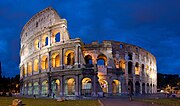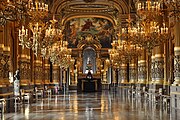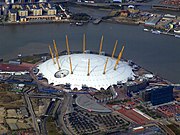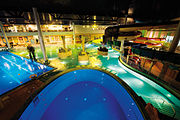Architecture

Architecture for entertainmentedit
Purpose-built structures as venues for entertainment that accommodate audiences have produced many famous and innovative buildings, among the most recognisable of which are theatre structures. For the ancient Greeks, "the architectural importance of the theatre is a reflection of their importance to the community, made apparent in their monumentality, in the effort put into their design, and in the care put into their detail." The Romans subsequently developed the stadium in an oval form known as a circus. In modern times, some of the grandest buildings for entertainment have brought fame to their cities as well as their designers. The Sydney Opera House, for example, is a World Heritage Site and The O₂ in London is an entertainment precinct that contains an indoor arena, a music club, a cinema and exhibition space. The Bayreuth Festspielhaus in Germany is a theatre designed and built for performances of one specific musical composition.
Two of the chief architectural concerns for the design of venues for mass audiences are speed of egress and safety. The speed at which the venue empty is important both for amenity and safety, because large crowds take a long time to disperse from a badly designed venue, which creates a safety risk. The Hillsborough disaster is an example of how poor aspects of building design can contribute to audience deaths. Sightlines and acoustics are also important design considerations in most theatrical venues.
In the 21st century, entertainment venues, especially stadia, are "likely to figure among the leading architectural genres". However, they require "a whole new approach" to design, because they need to be "sophisticated entertainment centres, multi-experience venues, capable of being enjoyed in many diverse ways". Hence, architects now have to design "with two distinct functions in mind, as sports and entertainment centres playing host to live audiences, and as sports and entertainment studios serving the viewing and listening requirements of the remote audience".
- Architecture for entertainment

Colosseum, Rome (70–80 AD), Roman venue for mass entertainment

The Grand Foyer in the Palais Garnier, Paris (1875), influenced architecture around the world.

Maracanã, Rio de Janeiro, at inauguration (1950) the world's largest stadium by capacity

The O₂ entertainment precinct, London (2007)

Flamingo Entertainment Centre, Vantaa (2008), include variety of entertainment activities (e.g. a movie theater, spa, bowling, laser games, virtual experiences), 40 different stores and hotel
Architecture as entertainmentedit
Architects who push the boundaries of design or construction sometimes create buildings that are entertaining because they exceed the expectations of the public and the client and are aesthetically outstanding. Buildings such as Guggenheim Museum Bilbao, designed by Frank Gehry, are of this type, becoming a tourist attraction as well as a significant international museum. Other apparently usable buildings are really follies, deliberately constructed for a decorative purpose and never intended to be practical.
On the other hand, sometimes architecture is entertainment, while pretending to be functional. The tourism industry, for example, creates or renovates buildings as "attractions" that have either never been used or can never be used for their ostensible purpose. They are instead re-purposed to entertain visitors often by simulating cultural experiences. Buildings, history and sacred spaces are thus made into commodities for purchase. Such intentional tourist attractions divorce buildings from the past so that "the difference between historical authenticity and contemporary entertainment venues/theme parks becomes hard to define". Examples include "the preservation of the Alcázar of Toledo, with its grim Civil War History, the conversion of slave dungeons into tourist attractions in Ghana, such as, for example, Cape Coast Castle and the presentation of indigenous culture in Libya". The specially constructed buildings in amusement parks represent the park's theme and are usually neither authentic nor completely functional.





Comments
Post a Comment